 
(the domes of S. Carlo al Corso and of St Peter's at sunset)
|
 | ||
The study and the actual building of various forms of domes became quite intense in the first half of the XVth century in northern Italy and in Tuscany, but not in Rome, where the authority of the Pope was challenged by the local factions. The first dome built in Rome after many centuries (San Teodoro) was designed in 1453 by Bernardo Rossellino.
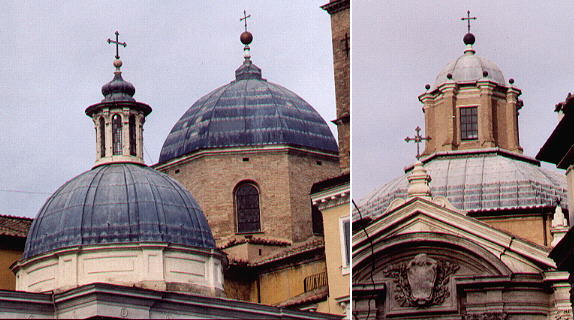 | ||
Sixtus IV (1471-84) was the first pope who embarked on a large program of public works. Santa Maria del Popolo was built during his pontificate by the association of the Lombards in Rome and its dome, most likely designed by Andrea Bregno, takes after models of Lombardy (the picture shows also the dome of Cappella Cybo built by Carlo Fontana in 1687). Santa Maria della Pace was initiated under Sixtus IV, but the dome was built in the XVIth century between 1520 and 1525 and it shows the three main elements of a dome: the drum, the vault and the lantern. At this time Rome already had one of the finest domes, a model for all the architects, the Temple built by Donato Bramante in 1502 in San Pietro in Montorio.
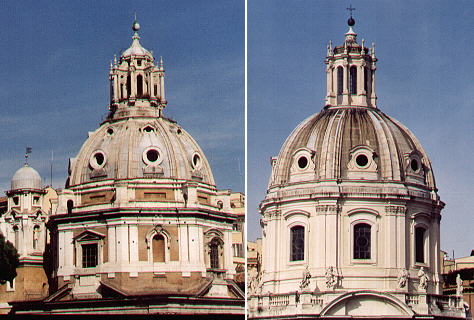 | ||
The building of S.Maria di Loreto took place over a 60 year span. It was originally designed by Donato Bramante in 1507, but very little was built for many years. In 1534 Antonio da Sangallo the Younger completed the lower, cube-shaped part, which was covered by a temporary roof. The dome was designed in 1573 by Jacopo del Duca, a scholar of Michelangelo, who designed also the little bell tower. The elaborated lantern inspired many Baroque architects including Francesco Borromini. In the XVIIIth century a church, SS. Nome di Maria, was built next to S. Maria di Loreto and its architect, Antoine Dérizet, designed a dome very similar to that of S. Maria di Loreto, thus creating another couple of domes (other couples existing at the time were: Santa Maria dei Miracoli and Santa Maria in Montesanto (in the background of this page); the two domes of Santa Maria Maggiore; Sant'Andrea della Valle and San Carlo ai Catinari (see below).
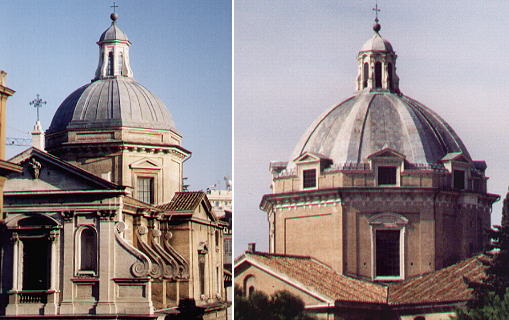 | ||
The greatest achievement of Giacomo della Porta is with no doubt the completion of St Peter's dome in 1590. Prior to that Giacomo della Porta had designed the domes of Madonna dei Monti and of Chiesa del Gesù. Both churches have a Latin cross shape and the domes can only be seen by moving to the side of the church or from higher ground (many pictures in this page were taken from the terraces of the Monument to Victor Emmanuel).
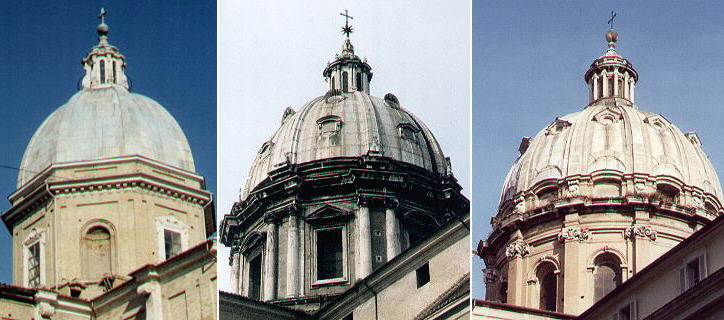 | ||
In the early XVIIth century the vertical development of the domes was increased in an attempt to improve their visibility. The dome of S. Giovanni dei Fiorentini, by Carlo Maderno (1614) ended up by being called Confetto succhiato (sucked comfit) because of its shape. Carlo Maderno also designed the second largest dome of modern Rome, that of S. Andrea della Valle (1622). The size and the shape of this dome are very similar to that of S. Carlo ai Catinari designed in 1620 by the monk Rosato Rosati. Because the two churches are not so far away, their domes form another couple (and add to the feminine side of the Roman skyline).
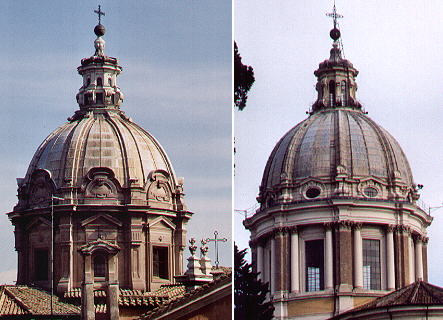 | ||
The only dome designed by Gian Lorenzo Bernini in Rome was the elliptical dome of Sant'Andrea dei Gesuiti al Quirinale. The domes designed by Francesco Borromini in San Carlo alle Quattro Fontane, Sant'Ivo alla Sapienza and Sant'Andrea delle Fratte all departed from the generally accepted dome structure. Pietro da Cortona who was both a painter and an architect designed two more traditional domes: SS. Luca e Martina in 1644 and S. Carlo al Corso in 1668. The two lanterns in particular are very similar.
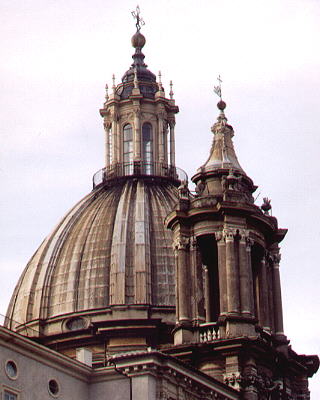 | ||
Francesco Borromini initially designed the dome of S. Agnese in Agone, but Carlo Rainaldi who took over from him in 1657 reduced by one fifth the height of the vault. Notwithstanding this the vertical drive of the dome is such that S. Agnese with its two high bell towers can be considered the final design of the Baroque model of church.
Domes
The table contains a list of historical churches with a dome:
| Name | (key) | Location - (Rione) | Notes |
| Chiesa del | Bambin Gesù (o di San Bernardo ai Monti) | I-Monti | Hardly visible from the street |
| Chiesa del | Gesù | IX-Pigna | Shown above |
| Chiesa della | Maddalena | III-Colonna | Not visible from the street |
| Chiesa della | Madonna dei Monti | I-Monti | Shown above |
| Santuario alla | Madonna dell'Archetto | II-Trevi | Not visible from the street |
| Chiesa del | Nome di Maria | I-Monti | Shown above |
| Chiesa | Nuova (S. Maria di Vallicella) | VI-Parione | The dome is visible in the View |
| Chiesa di | San Bernardo alle Terme | I-Monti | - |
| Chiesa di | San Carlo ai Catinari | VIII-Sant'Eustachio | Shown above |
| Chiesa di | San Carlo al Corso | IV-Campo Marzio | Shown above |
| Chiesa di | San Carlo alle Quattro Fontane | I-Monti | - |
| Chiesa di | San Giacomo in Augusta (o degli Incurabili) | IV-Campo Marzio | Hardly visible from the street |
| Chiesa di | San Giovanni dei Fiorentini | V-Ponte | Shown above |
| Chiesa di | San Giovanni della Malva | XIII-Trastevere | An 1846 addition |
| Chiesa di | San Giovanni in Fonte (Battistero Lateranense) | I-Monti | - |
| Chiesa di | San Giovanni in Oleo | X-Campitelli | - |
| Chiesa di | San Nicola da Tolentino | II-Trevi | Hardly visible from the street |
| Chiesa di | San Nicola dei Lorenesi | VI-Parione | Not visible from the street |
| Chiesa di | San Paolo alla Regola | VII-Regola | Hardly visible from the street |
| Chiesa di | San Patrizio (e Isidoro) | III-Colonna | Hardly visible from the street |
| Tempietto di | San Pietro in Montorio | XIII-Trastevere | - |
| Chiesa di | San Pietro in Vaticano | XIV-Borgo | - |
| Chiesa di | San Rocco | IV-Campo Marzio | - |
| Chiesa di | San Salvatore in Lauro | V-Ponte | The dome is visible from Castel Sant'Angelo |
| Chiesa di | San Silvestro al Quirinale | II-Trevi | - |
| Chiesa di | Santa Costanza | N.A. | - |
| Chiesa di | Santa Dorotea | XIII-Trastevere | The dome is visible in the View |
| Chiesa di | Sant'Agnese in Agone | VI-Parione | Shown above |
| Chiesa di | Sant'Agostino | VI-Parione | Covered by an ordinary roof |
| Chiesa di | Santa Maria dei Martiri (o della Rotonda) | VIII-Sant'Eustachio | The Pantheon (shown above) |
| Chiesa di | Santa Maria dei Miracoli | IV-Campo Marzio | - |
| Chiesa di | Santa Maria della Concezione a Campo Marzio | IV-Campo Marzio | - |
| Chiesa di | Santa Maria della Pace | V-Ponte | Shown above |
| Chiesa di | Santa Maria della Quercia (o dei Macellari) | VII-Regola | Not visible from the street |
| Chiesa di | Santa Maria della Rotonda (o dei Martiri) | VIII-Sant'Eustachio | The Pantheon (shown above) |
| Chiesa di | Santa Maria della Scala | XIII-Trastevere | Covered by an ordinary roof |
| Chiesa di | Santa Maria della Vittoria | II-Trevi | - |
| Chiesa di | Santa Maria dell'Orazione e Morte | VII-Regola | - |
| Chiesa di | Santa Maria del Pianto | VII-Regola | - |
| Chiesa di | Santa Maria del Popolo | IV-Campo Marzio | - |
| Chiesa di | Santa Maria del Rosario | N.A. | - |
| Chiesa di | Santa Maria di Loreto | I-Monti | Shown above |
| Chiesa di | Santa Maria in Aquiro | III-Colonna | Not visible from the street |
| Chiesa di | Santa Maria in Campitelli | X-Campitelli | - |
| Chiesa di | Santa Maria in Montesanto | IV-Campo Marzio | - |
| Chiesa di | Santa Maria in Traspontina | XIV-Borgo | Hardly visible from the street |
| Chiesa di | Santa Maria in Vallicella (Chiesa Nuova) | VI-Parione | The dome is visible in the View |
| Chiesa di | Santa Maria Maggiore | I-Monti | - |
| Chiesa di | Santa Maria Scala Coeli | N.A. | - |
| Chiesa di | Sant'Ambrogio della Massima | XI-Sant'Angelo | Not visible from the street |
| Chiesa di | Sant'Andrea dei Gesuiti al Quirinale | I-Monti | - |
| Chiesa di | Sant'Andrea della Valle | VIII-Sant'Eustachio | Shown above |
| Chiesa di | Sant'Andrea delle Fratte | III-Colonna | - |
| Tempio di | Sant'Andrea sulla Via Flaminia | N.A. | - |
| Chiesa di | Sant'Anna dei Palafrenieri | XIV-Borgo | - |
| Chiesa di | Sant'Antonio de' Portoghesi | IV-Campo Marzio | Shown below |
| Chiesa di | Sant'Apollinare | VI-Parione | Not visible from the street |
| Chiesa di | Santa Pudenziana | I-Monti | Shown below |
| Chiesa di | Sant'Eligio degli Orefici | VII-Regola | - |
| Chiesa di | San Teodoro | X-Campitelli | Shown above |
| Chiesa dei | Santi Celso e Giuliano | V-Ponte | Covered by an ordinary roof |
| Chiesa dei | Santi Claudio e Andrea dei Borgognoni | II-Trevi | - |
| Chiesa dei | Santi Giovanni e Paolo | X-Campitelli | The dome covers a chapel |
| Chiesa di | Sant'Ignazio di Loyola | IX-Pigna | Painted dome in the interior |
| Chiesa dei | Santi Luca e Martina | X-Campitelli | Shown above |
| Chiesa di | Sant'Isidoro (e Patrizio) | III-Colonna | Hardly visible from the street |
| Chiesa dei | Santi Pietro e Marcellino a Via Merulana | I-Monti | - |
| Chiesa di | Sant'Ivo alla Sapienza | VIII-Sant'Eustachio | - |
| Chiesa di | Sant'Omobono | X-Campitelli | Shown below |
| Chiesa di | Santo Stefano Rotondo | I-Monti | - |
| Chiesa della | Trinità degli Spagnoli | IV-Campo Marzio | Not visible from the street |
| Chiesa della | Trinità dei Pellegrini | VII-Regola | The dome is visible in the View |
| - | Sinagoga | XII-Ripa | - |
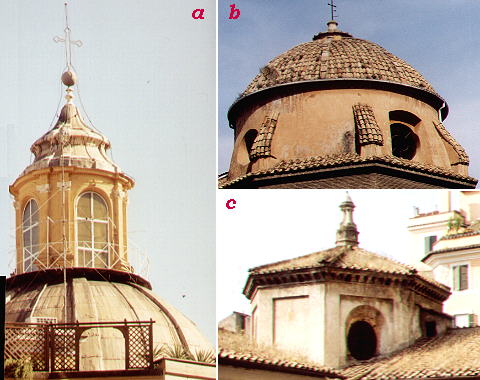 | ||
 or to
The Coats of Arms of the Popes or
to My Home Page on Baroque Rome or to
My Home Page on Rome in the footsteps of an XVIIIth century traveller
or to
The Coats of Arms of the Popes or
to My Home Page on Baroque Rome or to
My Home Page on Rome in the footsteps of an XVIIIth century traveller
All images © 1999 - 2003 by Roberto Piperno. Write to romapip@quipo.it
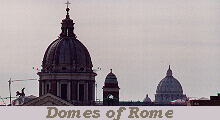 Domes of Rome
Domes of Rome